Photo

‘‘Dünya yüzündeki her çeşit orospulukta, her çeşit orospuda, bunlar ister kadın ister erkek olsun, ister cinsel ilintilerde ister haysiyet konularında orospuluk etsinler, bol bol aptallık bulunuyordu.’’
Kemal Tahir, Esir Şehrin İnsanları
Temmuz 2020, İstanbul
1 note
·
View note
Photo

İnekler havayı kirletir mi?
‘‘Sırayla gidecek olursak, öncelikle inekler havayı nasıl kirletir? Bütün mesele, neyi nasıl yedikleriyle ilgili. Sizden, benden farklı olarak ineklerin midesinde dört bölme vardır. Böyle bir mide sert, zor çiğnenen ve sindirilmesi uzun süren bir gıda olan otla beslenmelerini sağlar. Bir inek yediği otu midesinin ilk bölümünde depolar ki sonra bunu tekrar ağzına getirip çiğneyerek, yani geviş getirerek parçalayabilsin. İşte zaman zaman çiklet çiğner gibi görünmelerinin nedeni budur. Bölümlerin ikincisi, otu daha fazla parçalayan faydalı bakterilerle doludur. Bu işlem pis kokulu bir gaz olan metanın açığa çıkmasına neden olur ve inek bu gazı solunum havasıyla dışarı verir. İnsanlar da bazen - genellikle kuru fasulyeyi fazla kaçırdıklarında * metan gazı üretir, fakat bizde bu gaz diğer delikten çıkar. Zort! Ay, afedersiniz.’’
Gemma Elwin Harris, Küçük İnsanlardan Büyük Sorular Hayli Mühim İnsanlardan Basit Cevaplar
Temmuz 2020, Hamamözü
2 notes
·
View notes
Photo

“Evet, bir zamanlar gazetecilik yapma iradesi daha fazlaydı ama bunu ‘o güzel insanlar, o güzel atlara binip gittiler’ duygusallığıyla yaşayamayacak kadar kirli bir gazetecilik tarihimiz var.”
Ümit Alan, Saraydan Saraya Türkiye’de Gazetecilik Masalı
Haziran 2020, İstanbul
0 notes
Photo

“Bizim ömrümüz, bütün suçlarımızı muhaliflerimize yüklemekle geçmiştir. Büyük politika sandık bunu... Yatkınmışı, alıştık. Daha beteri, en suçlularımıza, en utanmazlarımıza uyarak, doğru söyleyenlere, hiçbir suçu olmayanlara diş biledik yıllarca... Giderek muhaliflerimizle aramızdaki ilintileri hırsızlarımız, alçaklarımız, manyaklarımız belirleyip denetler hale geldi. Bu heriflerin ne kadar rezil, ne kadar işe yaramaz olduklarını... Ne demek işe yaramaz! Tersine, kancıklıklarını... Aptallıklarını... Çalıp çırptıklarını bile bile, muhaliflerimizi en alçak iftiralarla karalamalarını beğeniyorduk, sırtlarını sıvazlayarak kışkırtıyorduk, mükafat olarak da çalmalarına, namussuzluklarına göz yumuyorduk.’’
Kemal Tahir, Kurt Kanunu
Ekim 2019, İstanbul
1 note
·
View note
Video
youtube
Medyaya neden güvenmiyoruz?
Ağustos 5, 2019
İstanbul
0 notes
Video
youtube
algoritmalar: dost mu düşman mı?
Mayıs 8, 2019
İstanbul
0 notes
Photo
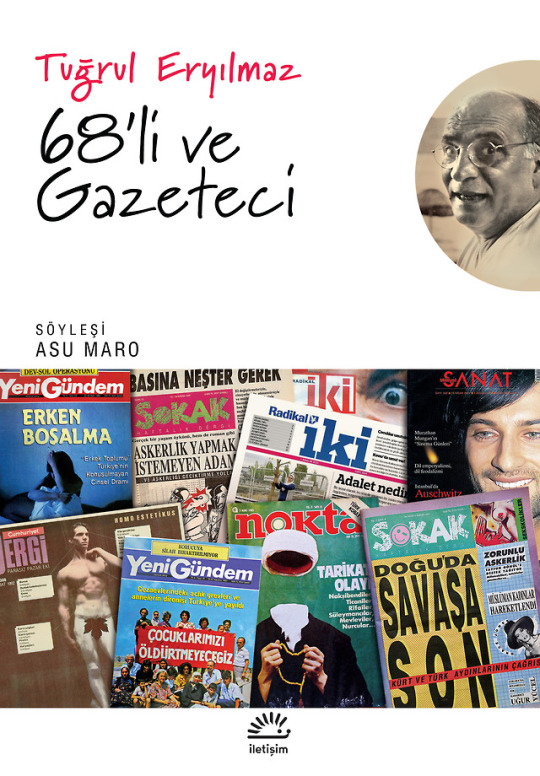
“Genel olarak konuşmak gerekirse dikkatli olmak çok kötü bir şeydir bir gazeteci için, fincancı katırlarını ürkütmemeye çalışmak, acaba ileri mi gittik diye endişelenmek. Ne kadar ileri gidebilirsin Allahını seversen: Ama o “Bize ne derler?” korkusu var ya, işte o gazeteciliğin en büyük düşmanı. Bugün artık bunlardan korkulmaya başlandı, bu korkunç işte. Cumhurbaşkanı kızacak, başbakan kızacak, yetmedi yoldaki üç tane ruh hastası kızacak, gelip bizi basacak diye, böyle gazetecilik olur mu?”
Asu Maro, Tuğrul Eryılmaz - 68'li ve Gazeteci s. 142
Mart 2019, El Nido
0 notes
Video
youtube
Suriyeli Mülteciler: #1 Olağan Şüpheliler
- 31 Ocak 2019
0 notes
Photo

“… If the world wakes up in time then we may be all right. Trust me, we do not want a world without news.”
Alan Rusbridger, Breaking News: The Remaking of Journalism and Why It Matters Now, p. 379
January 2019, Istanbul
0 notes
Video
youtube
Şehir Efsaneleri #1
Van Gölü Canavarı - aka Bestami
Ocak '19
0 notes
Video
youtube
teyitpedia #1
Sahte habere neden inanıyoruz?
Aralık ‘18
1 note
·
View note
Photo

‘‘ - Bir garip Yahudi varmış Karacahisar’da... Nerden gelmişse gelmiş... İki gözü kör... Düğünlerde, bayramlarda çalgı çalarmış, bahşişle geçinirmiş... Bir gün Kara Taun basmış buraları... Her evden birkaç ölü çıkmaya başlamış sabah akşam... Şimdiki Benito keşiş babamızın mağarasında, o zamanlar bir başka Frenk keşişi otururmuş... Sakallı göbeğinde bir domuz... Birkaç akılsız gitmiş Frenk keşişinden Kara Taun’un dermanını sora... Ne dese iyi, kara namussuz? ‘‘Ben yerinden haber aldım, taun maun yoktur. Yahudiler çeşmeleri, kuyuları ağılamaktadır. Yahudisini kesen kurtuluyor. Kurtulayım, derseniz, paralayın kör çıfıtı,’’ demiş... Bunlar gelip Karachisarlıları ayaklandırmışlar. Kudurmuş, Rab İsa beterinden esirgesin, bizim avanak Karacahisarlımız... Fukara kör Yahudi’yi döverek, söverek, Karacahisar’ın pazar yerine getirmişler. Rahmetli babam anlatırdı. Ölü gömmekten dönerken rezilliğin üstüne varmışlar. ‘‘Milletin kudurması nedir, ben o gün orada gördüm,’’ derdi rahmetli babam... Paralamışlar garip herifi... ‘‘Çıfıt zehrine panzehirdir’’ diye ayağından, etinden alan sütü bozuklar da olmuş... Babam rahmetli, ‘‘Üç gün karnım ekmek almadı. İçtiğim suyu kustum iki katıyla,’’ derdi. Bizim buraya göçmemiz, işte bu kör Yahudi olayındandır. ... Babam rahmetli, kör Yahudi işinde Karacahisarlıya kahredince, anamızı alıp gelmiş... Bakmış ‘‘Kanlı Boğaz Hanı’’ denecek, ‘’Issız handır buranın adı,’’ demiş... Çok yalvarmışlar yolunu kesmeye... Tekfurumuzun kahyası ‘‘Etme Kara Vasil, seni kurt kuş yer dağbaşında... Sana acımam körpe karınla karnındaki doğacağa acırım,’’ demişse de dinletememiş.’’ Sizden ırak olan, İsa efendimize yakın olur,’’ demiş rahmetli, ‘’Kötü adam görmenin, dine zararı vardır,’’ demiş.’’
Kemal Tahir, Devlet Ana
Aralık 2018, İstanbul
0 notes
Photo
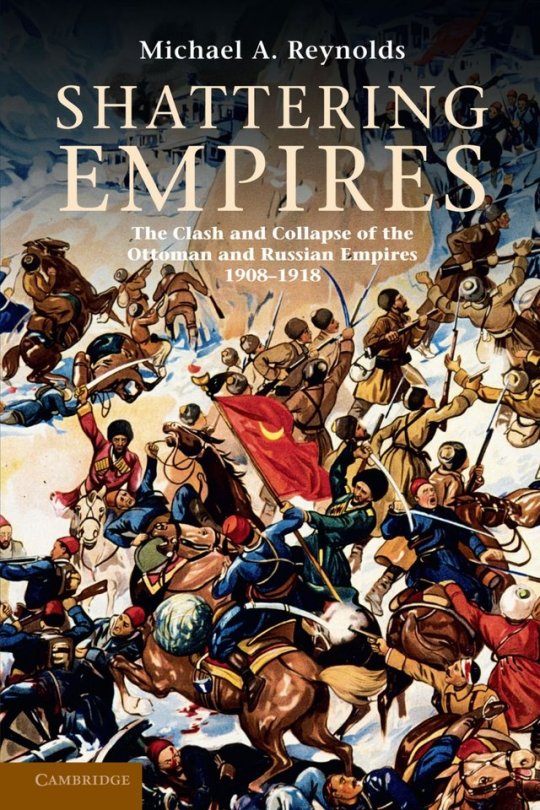
“The national idea had triumphed in form but not in content. The empires, or at least the defeated ones, were gone. Nation-states had been created, but some twenty-five to thirty million people, or nearly one-quarter of the states’ populations, were now officially minorities. The nations, too, had been shattered, first by warring empires and states and then by peacemaking ones.”
Michael A. Reynolds, Shattering Empires, p.266
November, 2018 - Istanbul
0 notes
Text
Sarah Marshall, Londra’daki City Üniversitesi’nde interaktif gazetecilik dersleri veriyor. Blog’unda paylaştığı ders notları, baya ilham verici. Ne güzel hoca. 😍
Lesson 1: The social, audience and growth roles within newsrooms

Not the modern journalism course timetable. Private Eye.
I’m about to meet my fourth cohort of Interactive Journalism MA students at City University, London.
I step out of my role as head of audience growth at Vogue International for two hours a week to teach the practical element of the social media, community and multimedia management module; Adam Tinworth teaches the theoretical side.
Here are my notes from the first lesson. This covers:
What does a social media editor do?
What’s audience development?
What is a growth editor?
How have these roles changed within the past year?
What are news publishers looking for in entry level social journalism graduates?
What does a social media editor do?
News organisations started to introduce social media editors about a decade ago to gather and distribute news via social, predominantly using Facebook and Twitter. Here’s an interview from 2009 with Alex Gubbay, the first social media editor at the BBC, explaining what his role would be.
Asked in the Guardian interview if he would play a role in the distribution of news, he said:
“Indeed, part of my work will be to extend the news and distribute them into the social networks, so that people can discuss them. We learn from the discussions that built on the stories themselves, pick up details we missed, or factor them into how we are approaching a story.”
The role was fairly similar – though needed less explaining to fellow journalists – when I joined The Wall Street Journal as a social media editor in December 2013.
I remember explaining back then that there were four areas to the role:
Engagement
Traffic
Reach / Brand awareness
Social newsgathering
Engagement
I first got interested in social media when, in 2007 and 2008, I was a broadcast journalist. The commercial radio station I worked for had fantastic community of people who would text in. This was the time that Facebook and Twitter started to gain traction and I enjoyed similar listener and engagement online. Ten years on and social provides a way for news brands to host communities of readers. This happens through commenting on site and social and Facebook groups, for example. A social media editor may respond to comments or take an action as simple as liking an Instagram post or Facebook comment, showing the reader the news brand is listening.
In 2014 I wrote how engagement is key to keeping people returning to a news site or brand.
Traffic
Facebook, Twitter, Pinterest, Reddit and other social platforms have been an important source of traffic to news sites. News startups sprouted up as Facebook and other platforms provided millions of eyeballs to stories. And while Facebook traffic has dropped significantly over the past year (more on that later), it still provides 28% of traffic to the news publishers that use Parsely, an analytics tool.
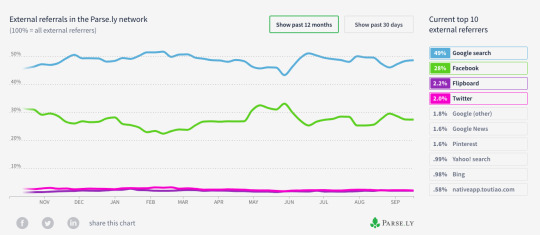
Reach / brand awareness
A social media editor also plays a role in increasing the brand awareness of a publication. I remember hearing Buzzfeed UK editor in chief Janine Gibson speak at Hacks/Hackers in December 2015 when Buzzfeed traffic had exploded. She made the point that even though the site of course cared about on-platform engagement, it was equally as important for Buzzfeed to have brand reach, whether logo on a social card on Twitter or a native post on Facebook.
Social newsgathering
Social newsgathering has become a whole field in itself, with agencies such as Storyful and organisations like Bellingcat being the pioneering experts. But for many social media editors, their role extends to monitor trends, hot topics and news events via social.
What is audience development?
Audience development roles have developed over the past five years. As this 2014 Digiday article notes, “The New York Times’ Innovation Report pointed out the need for audience-development specialists to get Times content in front of more readers.”
This 2017 Digiday article explains the current climate – and how audience development a focus for both the newsroom and for the commercial side of the business.
“Audience development has become core to how publishers scale and make money. But now the question facing publishers is how to ensure it serves all sides of the business, whose interests often conflict.”
“Once a role that mainly focused on SEO, audience development has become more complicated because of the explosion of ways publishers can find and distribute content, from their own platforms such as newsletters and apps to external ones such as social media outlets and bots.”
“At the most fundamental level, both the business and edit sides want to reach new and existing audiences. But from there the interests can diverge. Whereas the newsroom wants to maximize the reach and impact of its journalism, the sales side is rewarded for growing ad revenue, which could lead it to prioritize certain audience segments over others. And then there is driving subscriptions and marketing other products like events and commerce.”
Blogging about an ONA conference on audience development in 2016, I offered this definition of audience development
“Audience development is about taking the overall goals of the news organisation, whether they be advertising revenue and/or a growth in the number of paying subscribers, and working backwards to develop a strategy to help the news organisation achieve those goals.”
I still agree with my definition from a couple of years ago and expand it to say the field involves identifying a target audience and reaching those people and keeping them engaged.
And, of course, audiences may be engaged off platform. For example, launching Vogue on Snapchat has delivered millions of new, loyal weekly readers. But our owned and operated sites get zero traffic from Snapchat. So what’s in it for the publisher? Brand reach, young audiences and revenue share from the Snap advertising.
What does an audience growth editor do?
Julia Haslanger wrote this Medium post in 2015 answering that question. She quotes Thomas McBee, Quartz’s inaugural director of growth.
“McBee says that when there’s an obstacle to growth, it’s most often an editorial obstacle, such as a story not being framed or headlined in a way that will resonate with the audience.”
That still holds true. As head of audience growth I spend a lot of time guiding headline changes.
Here are Haslanger’s points on the role of a growth editor:
Identifying potential new audiences
Reaching out to people who might be interested in a specific story or event.
Shaping stories — and particularly headlines — to resonate with readers
Following up with new readers to build a relationship
Pushing the organization to go beyond the regular sources for stories
Analytics. Analytics. Analytics.
Assigning and shaping stories on trending topics
Events
I manage an eight-person audience growth team and consider our function as supporting the audience growth of the network of Vogues and GQs.
I’m advertising for a maternity cover and state in the ad that the primary function of my role as “responsible for audience development strategy, guidelines and a consistent approach to headlines, content packaging and SEO and identifying editorial opportunities based on audience data.”
Audience growth, in my view, relies on a three-part strategy:
Content strategy
Distribution strategy
Community strategy
The content strategy part includes:
Shaping stories. It’s helpful to think that every digital story starts with an audience of zero and it is our job as audience growth editors to find the right audience for that story.
Thinking audience-first in how people will find stories. That might mean commissioning a story that plays into a Pinterest trend, for example.
Guiding a broad offering of stories that appeal to large numbers of people
That includes evergreen content that delivers long-tail audiences
Shepherding in-depth, quality reporting that delights and keeps readers returning
Developing series to attract loyal readers
The distribution strategy part of the role includes:
SEO, social, email newsletter, and off-platform strategies
Working with product to ensure sites and platforms are optimised for search
The community strategy part includes:
Ensuring the brands host conversations and communities to keep people engaged and connected
And all of the above are underpinned with data.
What’s changed in the past year?
As this is my fourth year of teaching and updating my slides, it’s apparent that this year the social, audience and growth roles have shifted due to the Facebook algorithm change.
The move by Facebook to prioritise friend and family posts over those from news organisations and brands was announced in January. But Facebook traffic had been dropping for several months.
Data from Chartbeat (the first chart) and Parsely (the second chart) shows Facebook traffic declined throughout the previous year.
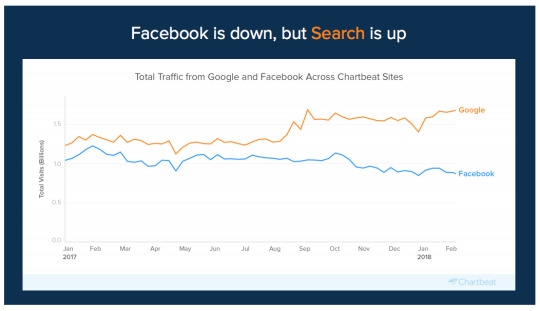
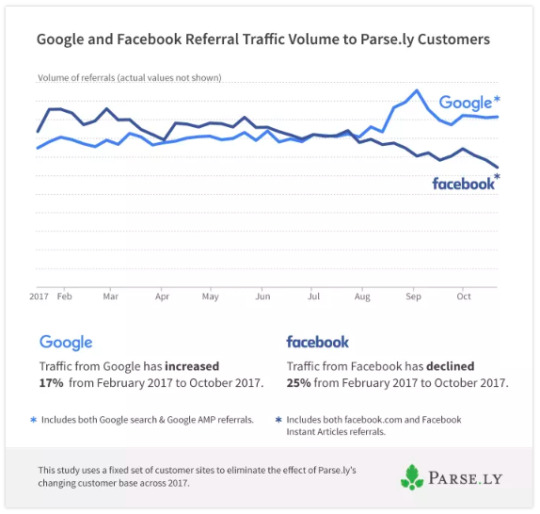
This algorithm change particularly hit VC-funded, ad-supported news startups including Mashable, Vice and Buzzfeed. But there have been positive stories for some publishers this year. Chartbeat noted in May that mobile direct traffic started to eclipse Facebook traffic, suggesting readers were going direct to sites rather than accessing via Facebook.
And social, audience and growth roles have shifted with the algorithms. The editors’ roles still include Facebook but there’s renewed focus on the following:
Search / SEO. You will have noted the rise in Google traffic in the charts above
Email newsletters, which offer direct relationships with audiences
Diverse and distributed traffic, including Flipboard, Pinterest, Upday, for example
What are news publishers looking for in entry level social journalism graduates?
In the final part if lesson 1, I take the students through the skills that publishers are looking for by going through job ads (such as this one, this one, this one, this one and this one.
I see my teaching role as equipping the trainee journalists with those skills so they are employable on graduating from the MA in 9 months’ time.
7 notes
·
View notes